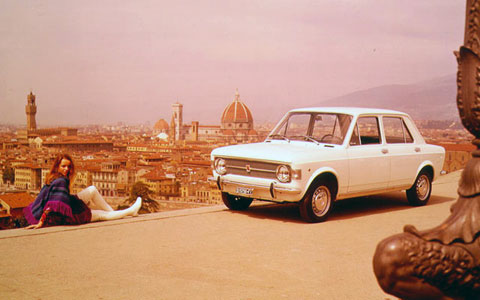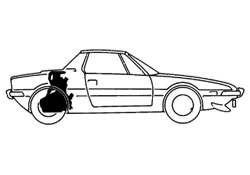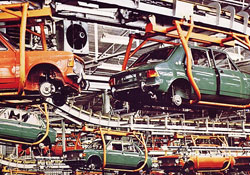
Zastava's 128 ("osmica") of 1971 is the company's first front-wheel-drive car
Front-wheel drive. Transverse engines. Maximum space utilization. These are the advances that will characterize Zastavas of the 1970s.
The first Zastava of the new decade is the
Zastava 128 ("osmica") sedan, courtesy Dante Giacosa's Fiat 128. Zastava begins producing the car not long after it is voted Europe's
Car of the Year, 1970. The first examples leave Kragujevac lines on May 16th, 1971.
This is the company's first front-wheel-drive car, debuting eleven years before Toyota attempts a front-wheel-drive layout. It is also the first front-wheel-drive, unibody sedan with all-around, fully-independent suspension. The innovative solutions put forward by the 128 will change the family car for good. So advanced and influential is the car that Fiat will make it for seventeen years; Zastava, for thirty-two.
"A driver's car with excellent brakes and outstanding handling," says
Road & Track of the car. Unlike rear-engined compacts such as Fiat's own 500; 600, and 950; Hillman's Imp; the Renaults 8 and 10; Simca's 1000, and the Volkswagen Beetle, the 128 is front-engined.

More than 230,000 Zastava 128s will be produced over thirty-two years
Moreover, contrary to Fiat's 124 and 125; Ford's period Escort; the Morris Minor; Opel's Kadett; Vauxhall's Viva, and various Datsuns and Toyotas, 128 is front-wheel-drive.
Neither Fiat nor Zastava ever look back.
The 128 has a brilliant new, rorty, overhead-camshaft engine. From a chassis point of view, it is the first car ever to field independent MacPherson struts all-around.
Chief Engineer Giacosa's new family car is a marvel not only of road manners and feisty durability (courtesy peppy SOHC motors), but of packaging.
In this respect, the 128 will be widely copied.
The Zastava 128: front-wheel-drive, a full eleven years before Toyota...
(more) 

Both the packaging and technical aspects of the 128 would be widely copied

The Zastava 128 begins production on May 16th, 1971, as exports of Zastava automobiles to Western Europe commence. More than 230,000 will be made until production formally ceases at the end of 2003. Production in kit form continues to this day.
Front-wheel-drive with a transverse-mounted engine, the 128 uses unequal-length driveshafts which allow the engine and gearbox to be located side-by-side. Virtually every mainstream manufacturer in the world finds itself copying this layout. Fiat will carry it forward to the 127 hatchback; Zastava, to the Yugo of the
1980s.
Two engines are available: a 55 hp (40.5 kW), 77.5 Nm, 1,116 cm
3 SOHC 1.1-liter, and a 65 hp (44 kW), 1,290 cm
3 SOHC 1.3-liter. A large bore and short stroke, together with an overhead-cam configuration, enable heady revs.
The motors are all new, and mark the first time that an overhead-cam configuration is available in an affordable automobile. They are designed by Aurelio Lampredi, whose name is associated with the 4.5-liter V12 in Ferrari's 1950 257S. At Fiat, Lampredi's work will be more important still: his 1.1-liter engine design will remain in production for thirty years hence, and it is still to be found under the hoods of two Zastava models today.
Both engines feature an aluminum alloy cylinder head with a direct overhad camshaft driven by a rubber toothed belt, another aspect destined to become adopted by rival small-car manufactures a decade hence, at the beginning of the 1980s.
Massively oversquare, with a short crank throw, the Fiat SOHC has such appetite for revolutions that Fiat uses it in its X1/9 sports car, where the entire drivetrain; suspension, and engine are moved to the rear for a mid-engined layout.

Such is the Fiat SOHC's appetite for revolutions that it finds a home in the X1/9 sports car, where the entire drivetrain; suspension, and engine are moved to the rear for a mid-engined layout

In one swoop, the innovative 128 heralds the end of the
continuous improvement that has defined the success of Volkswagen's Beetle. Innovation and reinvention are now the order of the day.
The last rear-engined Renaults are made in 1971. Within seven years, the Wolfsburg Bug has moved on to serve third-world markets. The days of rear-engined compacts are numbered, and rear-wheel-drive itself is under threat, given the space efficiency that Giacosa has demonstrated with front-wheel-drive. Even conservative Peugeot is soon to begin the switch.
Author and engineer Jeffrey Daniels writes that "the 128 certainly showed that, with a little ingenuity, the all-MacPherson suspension could be made to work very well - and its lesson was surely learned some thousands of miles away," in reference to the Toyota Camry which years later would pick up and continue the layout. Unfortunately enough, today's Camry is rather more overweight - more lethargic - than the vibrant 128 ever was. The layout no longer suits it.
The late automotive correspondent LJK Setright, recalling the 128 in his final book, called it "modest in size and brilliant in detail... it was this car which confirmed the pattern for all popular manufacturers to follow.
"Citroen had in 1934 made the front-wheel-drive car work... with the 128, Fiat made it good, resolving all the problems of erratic steeering, tricky handling, noise and tire wear and balance and habitability which had come to the surface in the previous generation.
"The 128 had modest dimensions, brisk performance, decent economy and uprecedented road manners; it also had front-wheel-drive, a transverse engine, an overhead camshaft, radial-ply tires and several other things that likewise have since been adopted by every serious maker of popular cars."
"There is scarcely any popular car... which does not embody the majority of the things which newly distinguished the Fiat 128 more than thirty years ago."
"Before long, VW of all people were making cars in the image of the Fiat 128 - and the world concluded that if VW, of all people, had abandoned its traditions and switched ends, this must be the right way to go."
"No single car has emerged since then to which we can point with gratitude for a major contribution to the emancipation that cars have progressively bestowed upon us" (Drive On! A Social History of the Motor Car, LJK Setright, Granta Books, 2003).
Jeffrey Daniels goes on to explain that the car "handled extremely securely, despite a tendency to lift its inside rear wheel when it was cornering really hard.

The 128 "handled extremely securely, despite a tendency to lift its inside rear wheel when it was cornering really hard"

"This happened despite the fact that there was an anti-roll bar at the front end only, giving an additional understeer effect.
"This suggests there was also some transfer of the lateral weight shift from front to rear as might be achieved through a nose-up roll axis.
"Actually, the fundamental difference between the two ends of the car was that while the front struts wore conventional concentric coil springs, the rear struts worked with either end of a transverse leaf spring, which would have given an anti-roll effect and, given Fiat's cunning, a progressive-rate spring effect into the bargain.
"The wheel-lift may also have had something to do with the downward migration of both roll centers so that the actual act of rolling further increased the body's roll moment. The most important thing in the Fiat chassis engineer's eyes would have been to ensure that it was the inside rear wheel, rather than the driven one, which lifted first.
"Unlike some of its rivals, the Fiat 128 rode notably well for no apparent reason: it felt as though the springing was soft by class standards, though ultra-soft springs and all-MacPherson-strut suspension are not normally easy bedfellows. This again suggests the 128 had its wheel travel limited by bump stops - and, of course, the progressive-rate springing at the rear would have given the impression of a soft ride as long as too much wheel travel was not invoked" (Car Suspension at Work, Jeffrey Daniels, Motor Racing Publications Ltd, 1998).
Today, the 128 continues production in completely-knocked-down (CKD) form. Imported to Egypt by Jugo Misir Trade and assembled by Cairo's El Nasco, the Zastava 128 remains among the best-selling cars in that market, even as Egypt assembles cars from 15 different passenger-vehicle manufacturers. Cab drivers, in particular, appreciate the Zastava's low running and maintenance costs. Approximately 100,000 Zastava 128s cruise Egyptian roads.
480 CKD Zastava 128s left for Egypt in February 2006, and another 480 in May 2006. The value of each export was rated at about $1 million. The 2,000 disassembled 128s delivered to Egypt that year marked an arrangement worth $5 million.

Zastava 101
("stojadin" or
"kec"): a legend is born. 1.5 million built -
and counting It does not take long for Zastava engineers to begin tweaking the 128.
Thanks to independent rear suspension featuring transverse leaf springs, the 128 offers excellent roadholding and space utilization.
Yet Zastava figures it could be more practical still.
As Zastava 128 sedans roll off the Yugoslav automaker's Kragujevac line, engineers amend the rear of the car to create a five-door version: the
Zastava 101. On October 15
th, 1971, the Zastava 101 becomes the first ever hatchback with engine and gearbox located astride each other.
It arrives a full three years before Fiat's own 128 3P and Volkswagen's Golf, assuring Zastava success as the company tenderly ventures into the markets of Western Europe.
Zastava's 101: Kragujevac adds what Fiat forgot...
(more) 

The Zastava 101 (5-door pictured): a more practical cousin of the 128, never produced by Fiat
Like the 128, the 101 offers a choice of 55 hp 1.1-liter or 65 hp 1.3-liter engines. 3-door and 5-door body styles are available.
With its 1.1-liter engine, the 835 kg 5-door 101 is capable of a top speed of 135 km/h.
Dubbed
stojadin and
kec in its home country, the 101 is exported to Western Europe. Its record year is 1979, when 88,918 copies leave the line.
By 1991, one million have been produced.
Britain will come to know it as the 3-door Yugo 311 and 5-door 513L. In France, where Peugeot has legal rights to the x0x scheme, it is dubbed the Zastava 1100.
Plus on en parle, plus on a envie de l'acheter, entices Zastava's French advertising ("the more you consider it, the more you want one").
With several modifications, the 101 continues production today as the
Skala 55. It is the world's second most-affordable car.
Zastava in 1973 makes 111,725 cars. A new agreement with Fiat in 1974 provides for closer cooperation on foreign markets.
The millionth Zastava is produced on December 15
th, 1975.
By 1975, Yugoslavia's appetite for cars has reached 300,000 per year. In 1977, Zastava's 30,000 employees produce 200,000 cars.
In May 1978, the number of passenger cars on Yugoslav roads surpasses 2 milllion, alongisde an estimated 22,000 buses; 300,000 trucks and other special vehicles, and more than 350,000 tractors in circulation. Every eighth of 22 million Yugoslavs is in possession of some type of transportation; every second of Yugoslavia's 5.5 million families enjoys either their own car, or some other type of motor vehicle.
In 1978, 243,639 Zastavas are made. In 1979 - when Kragujevac plant staff numbers 40,000 - 255,000 leave the line.
Zastava is now enjoying a turnover of about $2.2 million. It cooperates with about 200 Yugoslav enterprises. 500,000 people across the country are either directly or indirectly employed by Zastava.